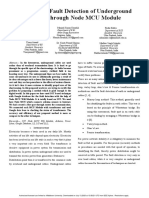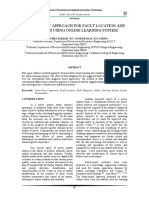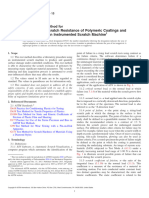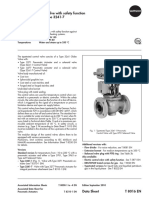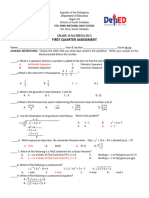Fault Detection and Localization in Transmission Lines
Step-by-Step Guide for Energy Hackathon (3-4 Days)
Objective:
Detect and localize faults (e.g., short circuits, line breaks, ground faults) in
transmission lines using advanced algorithms and real-time data analysis.
Day 1: Research and Planning
Morning: Problem Understanding
1. Understand Faults:
- Types: Short circuits, line breaks, grounding faults, overvoltage, etc.
- Key Indicators: Changes in current, voltage, frequency, and impedance.
2. Define Scope:
- Real-time monitoring and detection of faults.
- Fault localization (distance to fault or affected line section).
Afternoon: Technology Research
1. Research methods for fault detection:
- Impedance-Based Methods: Detect faults by analyzing changes in line
impedance.
- Wavelet Transforms: Use wavelet analysis to detect disturbances in the
signal.
- Machine Learning: Train models to classify fault types and locate them.
- Phasor Measurement Units (PMUs): Leverage synchronized measurements.
2. Select the approach that is feasible within the timeframe:
- Start with impedance-based or simple machine learning for rapid
prototyping.
- Use simulation software or real-time data from IoT sensors.
Evening: Planning and Task Assignment
1. Break the project into tasks:
- Data acquisition (real or simulated data).
- Algorithm development for fault detection.
- Visualization/dashboard for fault localization.
- Presentation preparation.
2. Assign roles to team members.
Day 2: Development of Core Features
Morning: Data Acquisition
1. Simulated Data:
- Use tools like MATLAB/Simulink or Python libraries to simulate fault
scenarios.
2. Real-Time Data (Optional):
- If accessible, connect sensors (e.g., Arduino, Raspberry Pi) to measure
voltage and current on a test circuit.
Afternoon: Fault Detection Algorithm
1. Develop Basic Detection Logic:
- For impedance-based detection, use Ohm's law and thresholds for abnormal
changes.
- For wavelet-based detection, use PyWavelets for signal analysis.
- For ML-based detection, train a simple classification model.
Evening: Fault Localization Algorithm
1. Distance to Fault Calculation:
- Use the impedance method or machine learning regression models for fault
location.
2. Validate using multiple fault scenarios.
Day 3: Integration and Testing
Morning: Prototype Integration
1. Combine Components:
- Integrate fault detection and localization algorithms.
2. Visualization:
- Plot results on a transmission line diagram using Plotly, Matplotlib, or
Grafana.
Afternoon: Testing
1. Test the prototype under different fault conditions.
2. Fix bugs or performance issues.
Evening: Final Touches
1. Optimize the System and Prepare Results.
Day 4: Presentation and Submission
Morning: Final Testing
1. Conduct end-to-end testing with multiple fault scenarios.
Afternoon: Presentation Preparation
1. Slide Deck:
- Problem Statement, Solution, Technology, Results, Impact, and Future Work.
2. Demo:
- Live or recorded demo showcasing functionality.
Evening: Rehearse Presentation
1. Refine Timing and Prepare for Questions.
Tools and Technologies:
- Simulation: MATLAB/Simulink, Python libraries (NumPy, SciPy).
- Algorithms: PyWavelets, scikit-learn, TensorFlow for ML.
- Visualization: Matplotlib, Plotly, Grafana.
- Hardware (Optional): Arduino, Raspberry Pi for real-time data.
Hackathon Deliverables:
1. Prototype: Functional fault detection and localization system.
2. Documentation: Explanation of algorithms, tools, and results.
3. Presentation: Slide deck and demo.
This structured plan will help you build and present a solid project in the
energy hackathon.






















